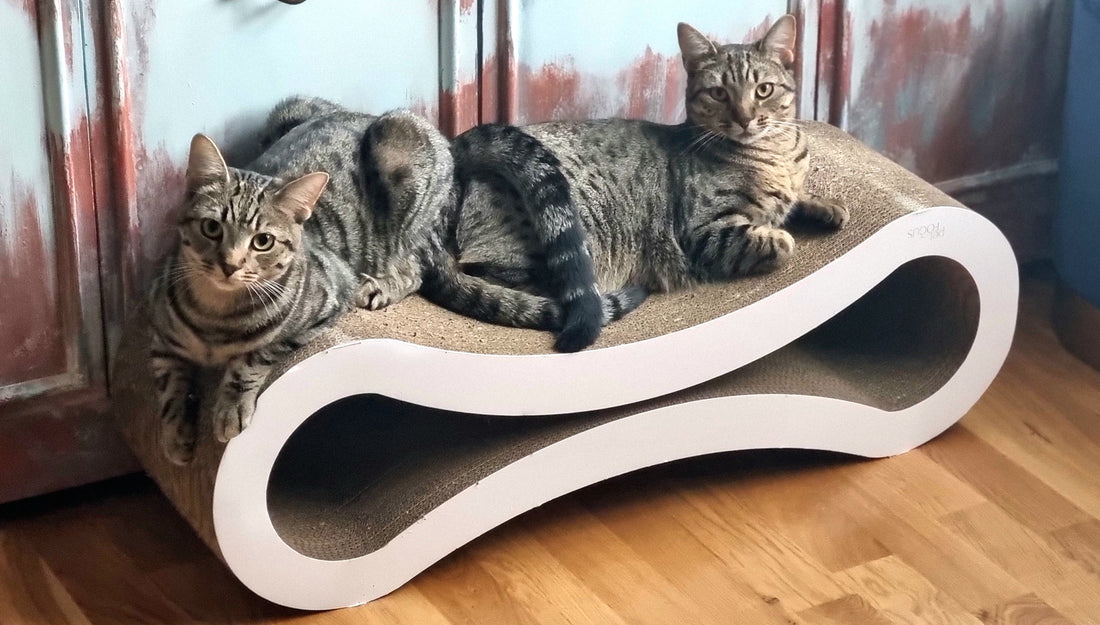
The Secret Language of Your Cat: Decoding Meows, Purrs, and Perplexing Tail Twitches Beyond the Basics
Share
Have you ever looked at your feline companion and wondered what's going on in that mysterious mind? As a cat parent to Kyro and Cleo, I've spent countless hours observing their unique communication styles. What started as confusion has evolved into a fascinating journey of understanding the nuanced language of cats. Let me share what I've learned about decoding these complex creatures.
 Decoding Kyro and Cleo's [Image by Hadinet Tekie]
Decoding Kyro and Cleo's [Image by Hadinet Tekie]
The Vocal Symphony: Understanding Your Cat's Meows
Living with Kyro has been like having a chatty roommate who never runs out of things to say. This vocal virtuoso has a different meow for every occasion — from his morning "wake up, I'm hungry" announcement to his playful "let's chase that toy" invitation. His vocal repertoire is astonishingly diverse and contextual.
Cleo, meanwhile, operates on a need-to-speak basis. Her vocalisations are primarily reserved for food-related requests, delivered with a precision that suggests she only spends her vocal energy on matters of true importance.
"The difference between a cat's 'feed me' meow and their 'I'm bored' vocalisation isn't just in pitch — it's in the duration, rhythm, and intensity. Once you learn to listen, you're essentially learning a new language."
Research suggests cats have evolved their meows specifically to communicate with humans, not other cats. Wild cats rarely meow beyond kittenhood, but domestic cats have adapted this sound as an effective way to train us. And trained me they have!
Decoding the Dictionary of Meows
I've learned that short, repetitive meows often signal excitement or greeting, while long, drawn-out sounds might indicate dissatisfaction or demand. Kyro's early morning vocalisations always start soft and gradually increase in volume — a calculated escalation strategy that ensures I can't possibly ignore him.
 Miaows Translator [The Spruce Pets]
Miaows Translator [The Spruce Pets]
The Purr Portal: What Those Vibrations Mean
Cleo is what I affectionately call "the little purring engine." Her purrs create a soothing soundtrack to our quiet evenings together. But I've discovered purring isn't always about contentment — it's far more complex.
Initially, I interpreted all purrs as happiness. Now I can distinguish between her relaxed, rhythmic purrs during cuddle time and the slightly more strained vibrations that precede a hairball episode. The difference is subtle but unmistakable once you've witnessed both.
Interestingly, Kyro was quite the purrer (is that even a word) as a kitten but has since traded this form of expression for his extensive vocal repertoire. This evolution of communication style fascinates me — it's as if he decided meowing gets faster results!
- Contentment purrs: Lower-pitched, steady rhythm
- Solicitation purrs: Higher-pitched elements interspersed with normal purring
- Self-soothing purrs: Often heard during minor discomfort or recovery

Purrrrring Time [Image by Animal Behaviour College]
Tail Tales: The Expressive Appendage
If you want to understand a cat's emotional state, watch their tail. Kyro's tail communication is particularly expressive—he walks with what I call a "twirly tail," proudly curved like a question mark and often swishing purposefully. Often, he wraps his tail around my leg or arm — a feline hug that melts my heart every time.
Cleo approaches tail language differently. Her "Miss Antenna" tail stands straight up most of the time, like she's perpetually searching for a signal. The only time this changes is when Kyro crosses some feline boundary — then her tail transforms into a windshield wiper of disapproval, swishing with unmistakable irritation.
The Nuanced Movements of Tail Communication
A cat's tail position and movement can reveal their current emotional state with remarkable precision. When Kyro rapidly flicks his tail tip from side to side, he's usually in a playful mood, almost inviting a game of "catch my tail." This contrasts sharply with the agitated, wide swings that signal frustration or overstimulation.
I've noticed that understanding these tail signals has significantly improved our relationship. By respecting their non-verbal boundaries, I've created a household where both cats feel understood and respected.
The journey to understanding your cat's secret language takes time and observation, but the rewards are immeasurable. Each day brings new insights into their complex communication system, deepening the bond we share. Whether it's through meows, purrs, or those perplexing tail twitches, our feline friends are constantly talking to us — we just need to learn how to listen.

Cat Tales [Image by Embrace Pet Insurance]
Answers to Frequently Asked Questions (FAQs)
Q1: Why does my cat twitch their tail so much?
A: Tail twitching often indicates curiosity or mild irritation. Rapid tail flicks can be a sign of frustration or overstimulation, especially during petting.
Q2: How can I tell if my cat is happy or upset?
A: Happy cats often purr, have relaxed body language, and slow blink at you. Upset or stressed cats may have flattened ears, dilated pupils, or a puffed-up tail.
Q3: Is it normal for my cat to meow a lot?
A: Yes, but pay attention to the tone and frequency. Excessive or loud meowing can suggest hunger, loneliness, or health issues.
Q4: Can I train my cat to communicate better?
A: While cats are independent, consistent positive reinforcement and paying close attention to their signals can foster better understanding.

"Food Time" [Image by Purina]
Warm Disclaimer: Please remember that the thoughts, experiences, and advice shared in this article are based on my journey as a cat owner with Kyro and Cleo in our London home.
Decoding your cat's meows, purrs, tail twitches, and other subtle cues can open a window into their inner world. By observing body language and contextual signals beyond the basics, you build a stronger, more trusting bond with your feline friend. Remember, every cat is unique, so patience and attentive observation are your best tools.
Embrace the journey of understanding your cat—each purr, twitch, and gaze is a word in their beautiful, secret language.
Always observe your cat's behaviour, be patient, and consult with a veterinarian or a certified cat behaviourist if you're facing significant challenges or have concerns about your cat's health or behaviour.
Start today by paying closer attention, and soon, you'll be speaking fluent feline!

